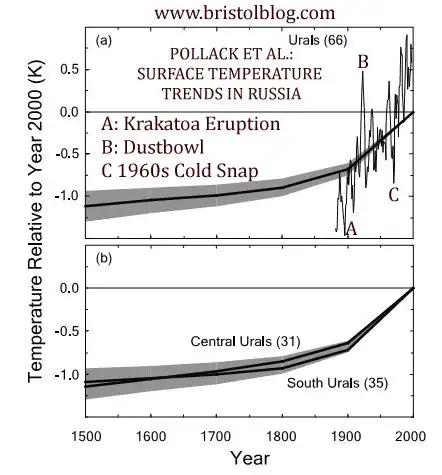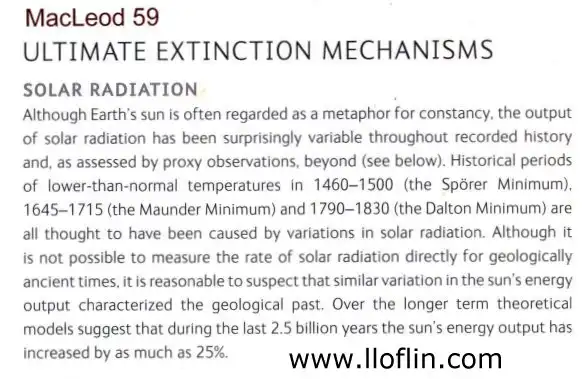
Urals temperature 500 years from bore holes.
Present Global Warming Began Circa 1800
by Lewis Loflin
Follow @Lewis90068157
To quote 11/21/22, The Virginian-Pilot story "New emissions cuts not part of historic UN climate deal."
The new (UN) pact does retain language to keep alive the global goal of limiting warming to 2.7 degrees Fahrenheit. The Egyptian presidency kept offering proposals that harkened back to language in the 2015 Paris accord that also mentioned a looser goal of 3.6 degrees. The world has already warmed 2 degrees since pre-industrial times.
Two degrees over 220 years is background noise.
Climate change is real and ongoing natural part of nature. It drove evolution, what is happening today started at the end of the Little Ice Age circa 1800-1850. Let's reduce waste and the use of fossil fuels for rational reasons.
Because we have severe cold and warm spells at differing times means little. In 2022 Europe is suffering through a drought the same as it did in 1920-21.
Another headline: "Dec 10, 2021 Historically frigid weather, tens of degrees below zero, has invaded northeast Russia, Scandinavia, Alaska and northern Canada in recent weeks."
Ref. www.washingtonpost.com.
This is illustrated in above. A series of borehole measurements in Russia allowed climatologists to reconstruct temperatures across Russia for the last 500 years.
This example is hysteresis, where climate change may take decades or centuries after the initial event to be measured. Or is a "slow motion" event taking many years. Scientists from the 1600s observed low sunspot activity, thus lower solar output.
About 1800 solar output increased, temperature increased in Russia by ~0.25 Deg. C from 1800-1900. It takes time to overcome changes in temperature, in this case cold oceans and ice cover slowed the process.
By 1900 to 2000 temperature increased another 0.75 Deg. C. Notice the many positive and negative spikes from 1800 to 2000. The overall average is positive.
Other studies in Russia and Eurasia reveal massive climate shifts between 6,000-11,700 years ago. BP is before present. To quote, "the mean July temperatures along the northern coastline of Russia may have been 2.5° to 7.0°C warmer than modern."
The study also notes changes in solar insolation.
Holocene Treeline History and Climate Change Across Northern Eurasia
Published online by Cambridge University Press: 20 January 2017
Ref. https://doi.org/10.1006/qres.1999.2123 Abstract:
Radiocarbon-dated macrofossils are used to document Holocene treeline history across northern Russia (including Siberia). Boreal forest development in this region commenced by 10,000 yr B.P. Over most of Russia, forest advanced to or near the current arctic coastline between 9000 and 7000 yr B.P. and retreated to its present position by between 4000 and 3000 yr B.P. Forest establishment and retreat was roughly synchronous across most of northern Russia.
Treeline advance on the Kola Peninsula, however, appears to have occurred later than in other regions. During the period of maximum forest extension, the mean July temperatures along the northern coastline of Russia may have been 2.5° to 7.0°C warmer than modern. The development of forest and expansion of treeline likely reflects a number of complimentary environmental conditions, including heightened summer insolation, the demise of Eurasian ice sheets, reduced sea-ice cover, greater continentally with ecstatically lower sea level, and extreme Arctic penetration of warm North Atlantic waters. The late Holocene retreat of Eurasian treeline coincides with declining summer insolation, cooling arctic waters, and neoglaciation.
Hysterical activists proclaim "'The treeline is out of control': how the climate crisis is turning the Arctic green." (The Guardian Jan. 20, 2022. To quote,
In northern Norway, trees are rapidly taking over the tundra and threatening an ancient way of life that depends on snow and ice. ... As the planet warms, the Arctic treeline is accelerating towards the pole, turning the white landscape to green. The trees used to creep forward a few centimeters every year; now they are leaping north at a rate of 40 to 50 meters a year. In the European Arctic, the birch is the leader of the pack.
Yes just like 6,000 years ago. The permafrost certainly melted releasing methane. The planet did just fine. To quote another hysterical report, their readings only go back to ~1979:
Russia is warming 2.5 times faster than the rest of the world. In 2020, regions across Russia have experienced the hottest temperatures on record, contributing to forest fires that burned through acreage the size of Greece and emitted one-third more carbon dioxide into the atmosphere than in 2019 (Russian forests account for one-fifth of the world’s total). Flash floods in Siberia destroyed entire villages and displaced thousands of residents. Snow coverage was at a record low in 2020, and Arctic sea ice coverage shrank to its second-lowest extent in over 40 years.
In 2023 that sea ice has recovered and is greater than 1981.
But that also means more plant life just like Norway. That means more wildlife, longer growing seasons, etc. Russia has been warming since 1800 and may continue to do so based on solar insolation and trace gasses such as CO2.
It has happened before and will happen again. The planet did just fine.
Other factors can come into play. Many glaciers formed during the Little Ice Age were melting. This means less reflected sunlight. Soot and pollution from industry settling on ice and glaciers may have accelerated their melting. This is positive feedback.
But this kind of pollution can work both ways by reflecting sunlight.

Solar radiation over the past 500 years.
The sun has grown brighter, perhaps since the 1800s. To quote NASA:
"Since the late 1970s, the amount of solar radiation the sun emits, during times of quiet sunspot activity, has increased by nearly 0.05 percent per decade, according to a NASA funded study. This trend is important because, if sustained over many decades, it could cause significant climate change. ... Historical records of solar activity indicate that solar radiation has been increasing since the late 19th century. If a trend, comparable to the one found in this study, persisted throughout the 20th century, it would have provided a significant component of the global warming the Intergovernmental Panel on Climate Change reports to have occurred over the past 100 years."
Ref. https://www.nasa.gov/vision/universe/solarsystem/solar_trend_change_climate.htm
This precisely tracks the borehole data from Russia. This trend is NOT a linear relationship.
Let me be clear: this DOES NOT explain all of the observed warming. Note these kinds of observations, before the 1970s, were not available.
There has been warming for over 200 years. Ice has been melting, and the oceans have been warming. As they gradually warm overall temperatures will increase.
So-called greenhouse gases certainly play a part; how great we don't know. As the oceans warm CO2 will be out gassed and less absorbed in addition to burning fossil fuels.
Sunspot activity measurements in the modern sense go back to 1755. Sunspots run in 11-year cycles, but their duration and intensity vary.
Present cycle 25 began in 2019 and "will increase until a peak sometime between 2023 and 2025." This trend means the atmosphere will heat up again and expand, putting a drag on satellites.
I'm guessing it will get warmer minus some form of negative feedback, such as a major volcanic eruption. See Climate Change and Volcanoes.
For example the Mt. Pinatubo eruption (western Luzon, Philippines) on June 15, 1991, (VEI-6) was "the second-largest terrestrial eruption of the 20th century." Sulfur aerosols dropped global temperatures ~0.5 Deg. C (0.9 Deg. F) for at least two years. I think it buried Clark Air Base.
There should be a temperature rise by the sun pumping more energy into the system heralding a rise in global temperatures. That happened in the late 1970s bringing down Skylab.
To quote,
The trouble was, the sun had other ideas. The very solar activity that Skylab had studied so fruitfully now turned against it. An unexpected rise in the number of CMEs and other radiation slamming into Earth heated our atmosphere so much that it expanded. This increased the drag on Skylab and began to pull it out of orbit faster than Nasa had reckoned.
"Skylab's orbit eventually decayed, and it disintegrated in the atmosphere on July 11, 1979, scattering debris across the Indian Ocean and Western Australia." WIKI.
Ref. The Guardian May 13, 2013. Skylab's 40th anniversary reminds us of the danger from space debris.
To further quote, "The first half of 2022 saw sunspot and solar flare activity on the sun increase significantly, including some of the most powerful flares seen in several years."
Ref. Sun's Upcoming Peak of Sunspot and Solar Flare Activity Could Set Records, Eric Mack August 5, 2022.
As I remember ice caps on Mars were shrinking at that time. NASA is quick to deny increased solar radiation is the cause.
- Observing Nature in the Real World
- Venus was Never Like Earth Science is Never Settled
- Mastodons Roamed Greenland 2 Million Years Ago
- Present Global Warming Began Circa 1800
- Dissecting Critical Climate Theory
- $1.5 Trillion Climate Change Industrial Complex
- Climate Change Cover for Spiritual & Social Revolution
- Corporate Welfare Grifters Climate Non-Crisis
- When Mythology Replaces Science
- Facts on Hurricanes and Tornadoes Past Present
- Why we should not fear nuclear power.
- Nuclear Graveyards Abound with Life
- What About Humans and Nuclear Radiation?
- Radiation Basics They Should Teach in High School
- How Woke Racism is Killing Education
- What PISA Scores Reveal About Immigration
- Deranged California Teacher Obsesses Over Race
- Lack of Ability is Not Systemic Racism
- Chicago Schools Ruined by Racial Diversity
- High scoring low-income students are white and Asian
- Michigan Muslim-Black Problem in Education
- Electronics, Nuclear Reactors, Applied Science
- Electronics and Technology Built at Home
- Off Site:
- Web Master
- Tri-Cities VA-TN
- General Science
- Hobby Electronics
- US Constitution
- Christianity 101
- Religious Themes
Web site Copyright Lewis Loflin, All rights reserved.
If using this material on another site, please provide a link back to my site.

